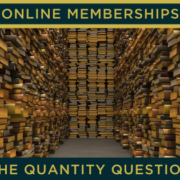Providing the fishing net
Providing the fishing net?
I can imagine you’re wondering what on earth I’m talking about and how this can possibly relate to content for income?
Bear with me and I’ll explain!
As the saying goes…
“Give a man a fish and you feed him for a day. Teach a man to fish and you feed him for a lifetime.”
So, when it comes to training, this is ultimately what you’re doing. You’re taking the current services you share with your clients and teaching them the lifetime skill of how to do it for themselves.
Before we go on, it’s worth repeating here the distinction between online memberships and training. Memberships require a monthly roll out of materials on an ongoing basis via an online platform. Training however can vary between in-person or provided online and as a once-and-done teaching experience or a series of lessons over a period of a few months. Or it can be a hybrid of all the above combinations and more. Either way there’s a clear point at which the delivery of content ends.
So, why training?
Training is a great way to generate extra income and opens up opportunities to become known in your area of expertise in a new way, while also moving you from a 1-to-1 to 1-to-many model.
This 1-to-many move allows you to extend your reach to people who might otherwise not be able to afford your 1-to-1 service, which is generally the most expensive way of working with someone.
Different ways to provide training
Gone are the days when the only way to provide training is in a classroom! Now you have the option of…
- Face-to-face
- Online live
- Online recorded
Let’s have a look at each of these in more detail.
Face-to-face
There are many benefits to providing training in a face-to-face classroom setting. Physically being in a room with your students feels more personal and allows you to manage people’s attention and energy levels, as well as engage them in practical exercises where needed.
In this face-to-face environment you can gauge how the information you’re sharing is landing and deal with any obstacles and questions in real-time as they arise. This can be invaluable for some students who might otherwise be reluctant to reach out and share within an online setting.
There’s also the benefit of having a captured audience. Those attending have clearly made a commitment of their time to be there and are away from offices and other distractions. This helps people to focus more fully on the content you’re sharing.
On the flip side, face-to-face of course means higher costs as you’re adding room hire, refreshments, printed materials, etc., into the mix. Your students will also need to take time out of their lives to be there, plus the additional cost of travel, convenience of location and potentially an overnight stay that they’ll need to factor in when deciding whether to sign up.
Online live
One of the huge benefits of any online training (whether it’s live or recorded) is the opportunity to reach a worldwide audience. The other bonus is the costs for you and your students are much lower – no room hire, no travel and all those other extra expenses that come with face-to-face.
For online live, your content is provided via real-time webinars. There are now a variety of different sophisticated platforms to choose from, with many offering breakout rooms, pop-quizzes and all sorts of other things.
Materials are delivered as downloadable PDFs that your students can either print, or you can make them editable so they can complete them in electronic format.
Online recorded
You have two options here. You can either run your training live first and make recordings of everything, or simply record your content privately and then share. A lot of people feel uncomfortable with the idea of being live with an audience, so the second option is perfect for them.
The great benefit of recorded online training is that your students can access the material at any time, and work through the content at their own pace. The potential downside is that the responsibility is entirely on them to complete it – it’s amazing how many people invest and then don’t complete! One way around this is to offer a Certificate of Completion, with a final exam that needs to be passed based on the content provided in the training.
The setup of recorded training can take time, effort and money, but once it’s done all your focus is then purely on marketing your great knowledge rather than delivering it multiple times.
If you’re interested in exploring these different ways of providing training but don’t know where to start, book a free content review call and we’ll chat through which option might work best for you.












Leave a Reply
Want to join the discussion?Feel free to contribute!